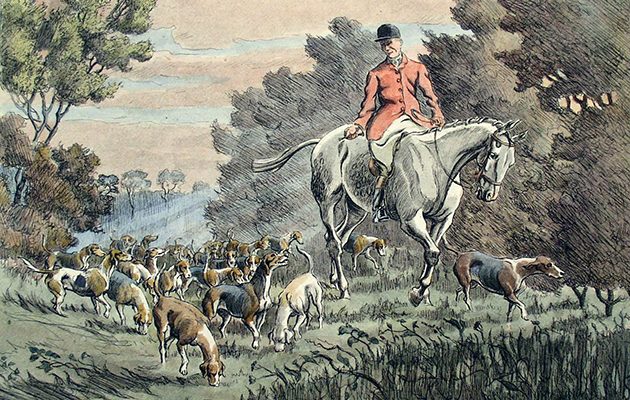Horsham Museum and Art Gallery is offering a timely reminder of Geoffrey Sparrow, a local son and a man of the countryside, as Janet Menzies explains
Geoffrey Sparrow served in the trenches, worked as a country doctor and was a true Corinthian sportsman. He painted ceaselessly throughout it all, offering hunting and country scenes from an insider’s perspective. Now Horsham Museum and Art Gallery are offering a timely reminder of his work, as Janet Menzies discovers.
For more sporting artists, the art of the Soper family provided the backdrop of our childhoods. And Owen Williams is inspired by watching wildlife at a time that belongs to nature rather than humans.
GEOFFREY SPARROW
When the final battle to save hunting was being lost, one of the greatest problems for hunters was that we were fighting for a concept so vanishingly spiritual that it couldn’t be articulated. If only the hunting artist, Geoffrey Sparrow, had still been alive it would have been easier. But he died in 1969, and Horsham Museum and Art Gallery is marking 50 years since then with a major retrospective exhibition of his work and life.

The Little Man at Rowland Ward’s.
Sparrow, born in 1887, was a true Corinthian sportsman. He was a country doctor in Horsham before the arrival of the M25. In the First World War he was decorated with the Military Cross. He served again in the Second World War, aged 53, and again received the Military Cross. Like most hunting folk, Sparrow rarely took himself seriously. Having studied at Cambridge University and St Bartholomew’s Hospital, London, he explained: “Something had to be chosen… I was offered the law, medicine or the Church: didn’t like an uncle who was a solicitor, so that was out; our parson was rather stout and greasy and preached long and dull sermons, and away with that, so there remained medicine.”
He sketched and painted unceasingly throughout his life, even during the First World War, and his diaries and account of the war, On Four Fronts with the Royal Naval Division, are littered with drawings and cartoons. His full-scale works concentrate on hunting and country scenes painted from an insider’s perspective – lively, fluid and, above all, authentic. Jeremy Knight, Horsham Museum & Heritage Officer, thinks Sparrow’s genuine engagement with Horsham life is an important reason for exhibiting him. “Sparrow came here in 1919 and he was widely influential and well-respected in the town. Horsham’s museum and art gallery was founded 125 years ago with a mission to collect local material that reflected the area’s culture, heritage and traditions. Sparrow’s work genuinely captures what life was like in the town in his time.”

Now hastes the whipper into the other side of the covert.
Commenting on the enthusiastic community support for the exhibition, Knight explains: “The group of people who are anti-foxhunting find any such imagery like Sparrow’s to be abhorrent but everybody else sees his paintings for what they are, and the community has a lot of nostalgia and warmth for them. We are receiving so many contributions for the exhibition – coming from as far as Spain and as near as the attic of one of our volunteers. Sparrow retired from medical practice in 1948 and there are still many local stories of him. He would ride up to a home visit, hitch up his horse, perform a delivery or take a blood pressure, then mount up and ride off again.
A RURAL COMMUNITY

ECH Dorney Common 1957.
“Horsham in the 1920s and ’30s was a market town that still saw itself as a rural community. The Crawley and Horsham Hunt used to meet in the town centre and the hunt still has foot followers locally known as the Geoffrey Sparrow Club. Although Sparrow’s paintings are related to hunting, really they are scenes of everyday people going about their lives in Horsham. He picked out the human idiosyncrasies of everyday life. His work has great warmth and humour. He would do a sketch for a child of a hedgehog doing the cleaning, or he would portray the cricket greenkeeper.”
Knight points out that Sparrow is really in the tradition of great caricaturists such as Rowlandson and Hogarth: “Like Hogarth, Sparrow’s work would often feature a dog, which was always doing something it shouldn’t be doing. Sparrow was light-hearted though – very accepting of human life and, in a way, almost praising it.”

Crawley & Horsham Carfax Meet ’48.
Sparrow went through many life experiences, from the trenches to the surgery, and his work reflects that, with a multi-layered, inclusive approach to what he saw around him. As the Horsham exhibition shows, hunting was deeply woven into the texture of everyday rural life, not just a bit of elitist fun. Now hunting is lost from the scene Sparrow painted. Insidiously, many more elements of that canvas are blanking out: the wider spectrum of community; the openness of countryside; the sense of tolerance for all; the joy of eccentricity. Sparrow’s life and work sums up the hunting ethos of social responsibility being a vital part of a sporting life well lived. In his autobiography, Foxes and Physic, Sparrow wrote: “I became thoroughly soaked in the tradition of fox hunting and have always held old Jorrocks’ opinion that all time not spent in hunting is wasted.” Luckily for us he “wasted” a good deal of his time being heroic; looking after other people; painting wonderful pictures; and generally enhancing life.
To find out about Horsham Museum and Art Gallery’s collection of pictures by Dr Geoffrey Sparrow, and its forthcoming exhibition, call 01403 254959 or go to: www.horshammuseum.org





